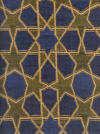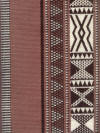|
|
the-south-asian.com July / August 2006 |
|
|||
|
August/September Contents
Sufis - wisdom against 50
years of mountain Heritage cities:
Cotton - the fibre of
|
|
||||
|
South Asian Handlooms & Natural Dyes By
Salman Minhas
Introduction: the birth, chilling and resurgence of Handlooms in South Asia. The history of craft, technology and art is the unleashed sum of energies of its people. Along the south Indus river at Mohenjo-Daro [ Sindh province –Pakistan], in the beginning [2000B.C.], simple peasant folk, guided by God’s light and nature, in harmony with the rhythms of natural cycles, the ebb and flow of tides, the waxing and waning of the moon, established the first brick houses and granaries for a settled civilization on earth. Inspired by the natural plant colours [indigo] and natural-organic fibres [cotton] of their local plants, these peasant folk rubbed a few sticks and threads together to eventually produce a handloom & dyeing technology that clothed Roman, Egyptian, Mughal emperors with their exquisite "woven-breezes = vetri-venti" = Dacca Muslins at the height of the Roman civilization. [ see our previous articles http://www.the-south-asian.com/May2004/cotton_industry_southasia.htm http://www.the-south-asian.com/June2004/south_asian_textile_industry-1.htm Right up to the 1600-1800s , south-Asian textiles [then India] dominated Europe and UK with their amazing natural coloured fabrics. Handloom – the great freeze Briefly during 1850-1980 these handloom and naturally coloured fabric suffered a freeze due to the Industrial revolution 1850-1980, and machine made and artificially coloured [German Azo- dyes] fabrics. Britain imported cotton from the southern U.S. slave cotton plantations and proceeded to drive the Indian and UK handloom weavers to near extinction. Lancashire and Manchester began the dominance of machine made textiles for another century . Man-made synthetic fibers came along with the introduction of Lycra and Polyesters Yarns by Dupont, etc. See the above references for details. In the villages of south Asia the handloom culture hid itself and refused to die – such was the strength of this technology. The Handloom also rises Gandhi resurrected the hand-woven cloth by the name of "Khadi or "khaddar" using the same basic spinning wheel and handloom technology. This handloom flame passed to a new generation of hands. Spinning is still done mostly by women and weaving by men called "Julahas" [weavers]. Kabir was one of those famous poet-weavers who is still remembered today when his poetry is sung as songs – the famous "Dohas" or couplets of Kabir. Natural dyeing Today almost all European countries have banned Azo Dyes. The country that initially made Azo dyes - Germany - was the first to impose the ban. The pesticides laden cotton is causing cancer and destroying the very eco-systems [ground water pollution] where cotton is grown. When babies suck on this type of cotton as babies often do, the chemicals in the cotton fabrics can cause serious damage to the child’s health. Humans also suffer health damage from all artificially dyed clothes and bed-sheets whose micro-fibres are inhaled every second of our life. Handloom History has come full circle. "Evisu" Jeans from Japan and others- "Agave" [see the article on Jeans "Old Jeans, new Genes" in http://www.the-south-asian.com/June2004/jeans1.htm ] today use natural indigo, making handloom denim to give you the best jeans in the world although at a premium of $ 200 per jean. The Handloom, the warp and the weft [Tana-Bana – as it is called in the local idiom in south Asia has persisted and made a come back in the present. Below is the story of one man from Lahore in Punjab, who took this handloom technology creatively into the homes of not just Pakistani houses, but captured the tastes of far-off Scandinavian, European, American customers from 1966 up to the present. Rahmani – student days and Handloom design Inspiration Wasi Rahmani [the name Rahmani is one of God’s hundred names in Arabic meaning the Compassionate – the name Wasi means the infinite] was born of humble farming parental stock, who had settled in Saharanpur [ famous for its mangoes]- northern India. His father eventually settled in Lahore and worked with the old Lahore Improvement Trust [ the City Authorities ]. Living in an old 3 –storey haveli near the civil Secretariat on lower Mall, as a young man, Rahmani says he used to climb to the roof of his house and look out onto the mazaar – tomb of Anarkali located in the Civil Secretariat buildings. Anarkali was the famous dancer who was buried alive and cemented into a wall by the Mughal king Akbar for falling in love with his son Salim. Rahmani says he is given to creative brooding and loves the melancholy [afsurda – mood indigo] emotion. In this state, he says he sketched the tomb of Anarkali many times. When the time came for him to get admission to the National College of Arts [ NCA], the then Principal [ Shakir Ali] asked him, can you draw ? and Rahmani says it was his sketches of the Anarkali tomb that got him a place . He graduated in 1966 with a diploma in Industrial Design from the prestigious National College of Arts [the old Mayo School of Arts – whose first principal was JJ.Kipling – father of Rudyard Kipling] in Lahore. His specialization was in Handloom weaving, textile designing, Hand Block Printing and Batik Decorative Panels. Rahmani’s inspiration comes from three main sources. The traditional Pakistani ethnic heritage - composed of village life, camel caravans, snake-charmers, owls, Monkey "Bandar"-walas, cock-fights, dancing horses, scenes of village working men and women, including Swati wood carving used in block printing. A few Batik prints showing the famous MohenjoDaro Dancing girl [ the original is about 4 inches in bronze in the New Delhi Museum] and dancing Camels and horses are given here. The rural paintings scenes of Ustad Allah Baksh, the famous NCA teacher and artist inspired Rahmani. The second source of his inspiration is the classical Mughal florals, the geometrics, the spaciousness and sheer grandeur of the roof and wall panels of Mughal forts and palaces. In his work on interiors, he is inspired by visualizing the interiors of houses with his handloom designs for curtains, sofas, chairs with various plaids, tweeds, herring-bone, tartan and Islamic geometric designs. Rahmani’s Handloom Fabrics –Work Milestones. He started off in 1966 with his thesis exhibition at the NCA . In a burst of creative energy this was followed by an exhibition of Handloom Design and Batiks called "Artisans at work" at the Punjab University. In 1967 Rahmani opened an outlet in Gulberg- Lahore, where he still lives, followed by offices in Rawalpindi, and subsequently to Islamabad, and also an outlet in Karachi. In 1967 his handloom textiles appeared in an exhibition representing Pakistan craft at the Vienna World Fair. It was completely sold out. Rahmani handloom fabrics have graced the Hotels of Aga Khan in Pakistan They are at the Serena Lodges at Quetta and Faisalabad and they were selected by Shah Begum, a Latin–American designer associated with the Agha Khan Foundation. Rahmani’s fabrics were also used in 1976 to furnish the interiors of the then Intercontinental Hotels at Lahore and Rawalpindi – for this Michael Cole, the representative of the New York Designer Dale Keller was the main interface. The Sheraton Hotel in Karachi [working with George Freeman, a London-based designer] and the Holiday Inn at Karachi [ with William Chow, a Chinese designer] also use his handloom fabrics. Mock-up hotel rooms were set up for approval. In addition Rahmani made handloom fabric for the colours of the Pakistan Army Baluch regiment and the Northern regiment of the Pakistan Army [ with a Maple leaf block print in a rust colors]. In addition he has done work for the SOS Villages in Lahore, by helping them set up a handloom operation, Bahawalpur Public school – south Pakistan, the Korean Embassy in Islamabad, personal orders for the Bhandaris of Murree Breweries, Pakistan. At the peak of his handloom production Rahmani provided employment to as many as one hundred women weavers and cotton yarn spinners in and around Lahore Handlooms, Natural Colours & Organic Cotton- The advantage: Handlooms uniquely retain the ability to customize and improvise small scale fabrics such as Durrees [ the name for cotton, wool , or even man-made fibers rugs or carpets ] or house interior fabrics. Machine made [mass-produced] fabric is unable to offer this unique originality and customization ability. Thus the customers’ tastes, their originality and individual fabric design is retained and not repeated ad nauseam as is the case with mass-produced fabrics. Durrees are very tough but less expensive than hand knotted carpets. They have been made since long and are well known now in he west since IKEA and major US & UK and European stores [ Bloomingdales, etc ] started to import them since 1980’s from south- Asia. "Shyam Ahuja" is a big name with a big price tag. Rahmani Fabrics is currently involved in carrying out research & development in the use of natural vegetable and fruit colours for their handlooms. In this area, they have used natural indigo plants[ blues], marigold flowers [yellows], red-mulberry [shahtooth- maroons], walnut [ brown colors], pomegranate [reds], madder root [brick-reds], henna [rusts-orange] , etc. He is also identifying organic cotton sources in south Asian countries, India & Pakistan for use in handloom fabrics when a customer specifies its use. In addition he aims to educate the farmers, via various forums, in south-Asia, to switch to organic cotton due to the long-term benefits and overall eco-friendly and economic aspects.
*****
|
|||||
|
Copyright © 2000 - 2006 [the-south-asian.com]. Intellectual Property. All rights reserved. |
|||||


